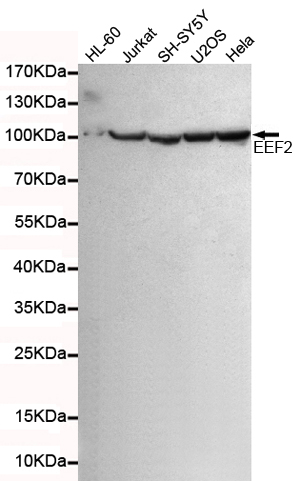eEF2 Antibody
Purified Mouse Monoclonal Antibody (Mab)
- 产品详情
- 实验流程
- 背景知识
Application
| WB, ICC |
|---|---|
| Primary Accession | P13639 |
| Reactivity | Human |
| Host | Mouse |
| Clonality | Monoclonal |
| Isotype | IgG2b |
| Calculated MW | 95338 Da |
| Gene ID | 1938 |
|---|---|
| Other Names | EEF2;Eef2;EF-2;EF2;EF2_HUMAN;Elongation factor 2;Eukaryotic translation elongation factor 2;Polypeptidyl tRNA translocase;SCA26. |
| Dilution | WB~~1:5000 ICC~~1:200 |
| Format | Liquid in PBS containing 50% glycerol, 0.5% BSA and 0.02% sodium azide, pH 7.3. |
| Storage | Store at 4°C short term. Aliquot and store at -20°C long term. Avoid freeze/thaw cycles. |
| Name | EEF2 |
|---|---|
| Synonyms | EF2 |
| Function | Catalyzes the GTP-dependent ribosomal translocation step during translation elongation (PubMed:26593721). During this step, the ribosome changes from the pre-translocational (PRE) to the post- translocational (POST) state as the newly formed A-site-bound peptidyl- tRNA and P-site-bound deacylated tRNA move to the P and E sites, respectively (PubMed:26593721). Catalyzes the coordinated movement of the two tRNA molecules, the mRNA and conformational changes in the ribosome (PubMed:26593721). |
| Cellular Location | Cytoplasm. Nucleus. Note=Phosphorylation by CSK promotes cleavage and SUMOylation-dependent nuclear translocation of the C- terminal cleavage product. |
For Research Use Only. Not For Use In Diagnostic Procedures.
Provided below are standard protocols that you may find useful for product applications.
BACKGROUND
Catalyzes the GTP-dependent ribosomal translocation step during translation elongation. During this step, the ribosome changes from the pre-translocational (PRE) to the post- translocational (POST) state as the newly formed A-site-bound peptidyl-tRNA and P-site-bound deacylated tRNA move to the P and E sites, respectively. Catalyzes the coordinated movement of the two tRNA molecules, the mRNA and conformational changes in the ribosome.
REFERENCES
Rapp G.,et al.Biol. Chem. Hoppe-Seyler 370:1071-1075(1989).
Hanes J.,et al.Biol. Chem. Hoppe-Seyler 373:201-204(1992).
Ustek D.,et al.Submitted (FEB-2005) to the EMBL/GenBank/DDBJ databases.
Mural R.J.,et al.Submitted (SEP-2005) to the EMBL/GenBank/DDBJ databases.
Rapp G.,et al.Biol. Chem. Hoppe-Seyler 369:247-250(1988).
终于等到您。ABCEPTA(百远生物)抗体产品。
点击下方“我要评价 ”按钮提交您的反馈信息,您的反馈和评价是我们最宝贵的财富之一,
我们将在1-3个工作日内处理您的反馈信息。
如有疑问,联系:0512-88856768 tech-china@abcepta.com.























 癌症的基本特征包括细胞增殖、血管生成、迁移、凋亡逃避机制和细胞永生等。找到癌症发生过程中这些通路的关键标记物和对应的抗体用于检测至关重要。
癌症的基本特征包括细胞增殖、血管生成、迁移、凋亡逃避机制和细胞永生等。找到癌症发生过程中这些通路的关键标记物和对应的抗体用于检测至关重要。 为您推荐一个泛素化位点预测神器——泛素化分析工具,可以为您的蛋白的泛素化位点作出预测和评分。
为您推荐一个泛素化位点预测神器——泛素化分析工具,可以为您的蛋白的泛素化位点作出预测和评分。 细胞自噬受体图形绘图工具为你的蛋白的细胞受体结合位点作出预测和评分,识别结合到自噬通路中的蛋白是非常重要的,便于让我们理解自噬在正常生理、病理过程中的作用,如发育、细胞分化、神经退化性疾病、压力条件下、感染和癌症。
细胞自噬受体图形绘图工具为你的蛋白的细胞受体结合位点作出预测和评分,识别结合到自噬通路中的蛋白是非常重要的,便于让我们理解自噬在正常生理、病理过程中的作用,如发育、细胞分化、神经退化性疾病、压力条件下、感染和癌症。







